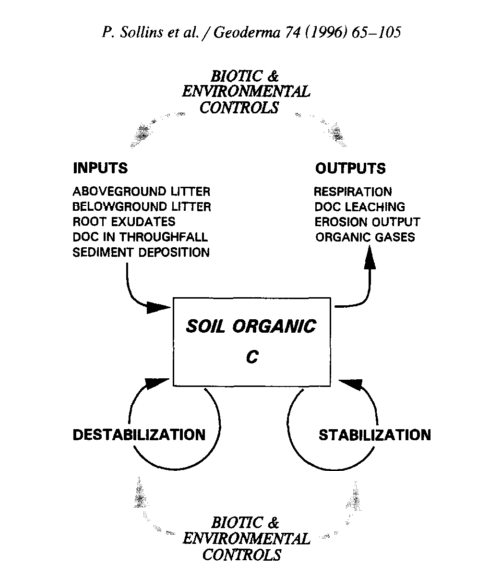The Conundrum of Soil Organic Material (SOM)
It’s hard to pinpoint individual controls of SOM storage because soils are highly heterogeneous and there are many potential processes occurring across multiple scales. From the the nano-scale interactions between minerals and SOM to the macro-scale protection of large SOM particles by aggregates, soil systems are complex and hard to study.
Historically, SOM was believed to condense into larger molecules that are more recalcitrant (chemically resistance to decay) and persist in soils, a theory known as “humification”, and a lot of work in soils in centered around this idea. However, we have come to understand that humification as a theory doesn’t make sense. Movement away from humification theory was catalyzed by improvements in measurement and visualization of the soil system by techniques like nuclear magnetic resonance (NMR) and in-situ soil chemistry that showed that complex “humic” macromolecules are not prevalent in soils. Instead most SOM resembles biomolecules created by plants and microbes.
](https://media.springernature.com/m685/nature-assets/nature/journal/v478/n7367/images/nature10386-f2.2.jpg#right) Figure 2. How our view of SOM has changed as we employ new soil measurement techniques. For full figure text see Schmidt et al. (2011) DOI: 10.1038/nature10386
Figure 2. How our view of SOM has changed as we employ new soil measurement techniques. For full figure text see Schmidt et al. (2011) DOI: 10.1038/nature10386
Though it has long been understood by soil scientists that discrete stabilization mechanisms are at work in soils, there has been a lack of acceptance of these ideas in adjoining disciplines that also deal with soils. Everyone who works with soils should consider physical disconnection, sorption/desorption, and freeze-thaw cycles as key mechanisms controlling SOM sequestration. It is also important to understand that carbon inputs into soils are largely controlled by the rhizosphere.
](https://media.springernature.com/m685/nature-assets/nature/journal/v478/n7367/images/nature10386-f3.2.jpg) Figure 3. An emerging understanding of stabilization/destabilization processes has replaced humification theory. For full figure text see Schmidt et al. (2011) DOI: 10.1038/nature10386
Figure 3. An emerging understanding of stabilization/destabilization processes has replaced humification theory. For full figure text see Schmidt et al. (2011) DOI: 10.1038/nature10386
List of important publications:
Schmidt et al. (2011) DOI: 10.1038/nature10386
Rethinking the Conceptual Theory of SOM Sequestration
In contemporary times we’ve come to think of SOM storage as a process of stabilization and de-stabilization by multiple discrete mechanisms in the soil, an idea that was first conceptualized well by Sollins and co-authors circa 1996.
 Fig 1. Sollins et al. (1996) is a fantastic paper that brings together many of the budding ideas in soil science at the time. It is a concrete and well discussed paper on how SOM storage can be conceptualized
Fig 1. Sollins et al. (1996) is a fantastic paper that brings together many of the budding ideas in soil science at the time. It is a concrete and well discussed paper on how SOM storage can be conceptualized
As paradigms have shifted, its important to get away from humification terminology and embrace mechanistic theories and conceptualizations of soil carbon stabilization. Below is a visualization of multiple conceptualizations of SOM sequestration and a final consolidated view of SOM sequestration by Lehmann & Kleber (2015).
](https://media.springernature.com/m685/nature-assets/nature/journal/v528/n7580/images/nature16069-f2.jpg) Figure 4. The soil continum model (SCM) is an attempt to bring together disparate conceptualizations of soil carbon storage, which is an important step forward in soil science as we try to determine the best measurement and modeling techniques to predict SOC changes. For full figure text see Lehmann & Kleber (2015) DOI: [10.1038/nature16069
Figure 4. The soil continum model (SCM) is an attempt to bring together disparate conceptualizations of soil carbon storage, which is an important step forward in soil science as we try to determine the best measurement and modeling techniques to predict SOC changes. For full figure text see Lehmann & Kleber (2015) DOI: [10.1038/nature16069
Importantly, Lehmann & Kleber (2015) illustrate aggregation and mineral sorption as key processes in SOM storage. They also point out that biopolymer size determines assimilation by microbes. Though not definitive, the SCM model is an important step towards an accurate conceptualization of SOM storage.
List of important publications:
Sollins et al. (1996) DOI: 10.1016/S0016-7061(96)00036-5
Lehmann & Kleber (2015) DOI: 10.1038/nature16069
Moving forward: bringing together theory, measurement, and modeling
New work by Vidal et al. (2018) has highlighted important interactions in the rhizosphere between plant roots, fungi, and bacteria. The hope is that research like this will inform how we think about SOM and eventually lead to new conceptualizations of SOM storage that can be tested, further refined, and finally modeled to help project future changes in SOC.
](https://www.frontiersin.org/files/Articles/331687/fenvs-06-00009-HTML/image_m/fenvs-06-00009-g009.jpg) Figure 5. Recent labeling and imaging techniques have given an amazing look into new conceptual models of root driven SOM storage. For full figure text see Vidal et a. (2018) DOI: 10.3389/fenvs.2018.00009
Figure 5. Recent labeling and imaging techniques have given an amazing look into new conceptual models of root driven SOM storage. For full figure text see Vidal et a. (2018) DOI: 10.3389/fenvs.2018.00009
Moving forward there needs to be a focus on connecting theory, measurement, and modeling as a single process. When separated we fail to close the loop of the scientific method and have difficulty informing further research. Only by designing experiments to test conceptual theory and provide data to model soil systems will we be able to provide farmers, land managers, policy makers, and the general public with tools to better understand soil carbon.
List of important publications:
Blankinship et al. (2018) DOI: [10.1007/s10533-018-0478-2] (https://link.springer.com/article/10.1007/s10533-018-0478-2)
Vidal et al. (2018) DOI: 10.3389/fenvs.2018.00009